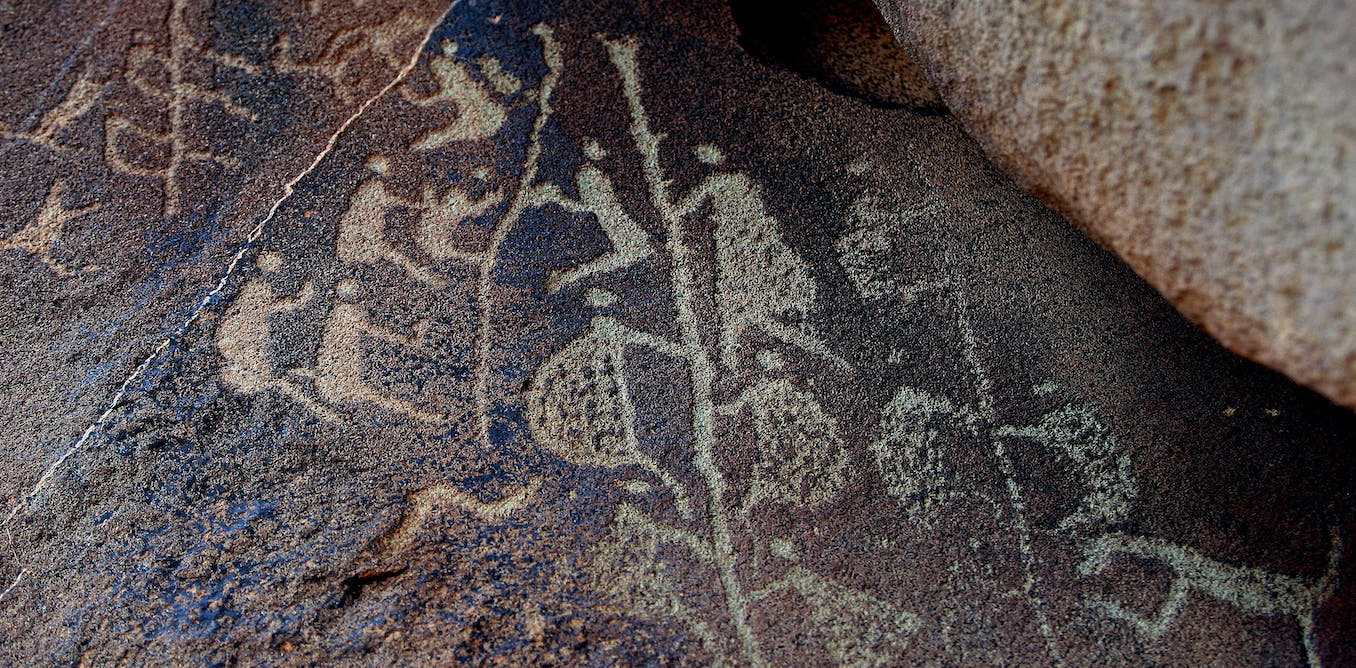Want to preserve Australian values? Start with the Burrup Peninsula
Most people know the Burrup Peninsula – if they know it at all – from TV footage of gas tankers powering through the impossibly blue channels of the Dampier Archipelago, delivering gas to an energy hungry world from the processing plants on the remote Pilbara coast.
But in the background to these images is the most significant heritage site in Australia. It is the only Australian site to have been placed on the World Monuments Fund’s list of the 100 most endangered places.
For on the Burrup – or to give it its indigenous name Murujuga – is the densest concentration of rock art in the world, estimated at perhaps as many as a million petroglyphs. Some have described it as “the world’s largest gallery of engraved prehistoric art”.
And despite the fact that it is now on the Australian Heritage List, most Australians are almost entirely ignorant of its existence.
Rock carvings are scattered through the barren rocky ridges and steep-sided valleys of the peninsula and the surrounding islands. The oldest of the art work is believed to date from the period when the Burrup was an inland range, before the inundation which drowned much of the surrounding landscape over 9000 years ago.
With European settlement, as was so often the case in our history, came devastation for the original inhabitants of the peninsula, the Yaburara people. Many were massacred in 1868.
Among the distinctive images are geometric designs, tracks of humans, animals and birds. There is a huge variety of both naturalistic and figurative representations of humans and animals. Some are so detailed that they can be identified as particular species.
The rock art includes depictions of Thylacines or Tasmanian tigers, extinct on the mainland for over 3000 years. There are panels and composite images of daily activities, such as hunting, which have clearly been added to over long periods of time.
Many different engraving styles are represented – scored lines made with a very fine pointed rock, pecked marks, abraded lines and indents in the dark red-black glossy patina that covers the rocks in this area.
The “fine execution”, the “dynamic nature” of the images and the high degree of creativity have often been admired by those fortunate enough to have visited the site. For many it has been a revelatory experience.
This extensive precinct covers 42 islands over a 45km radius. The range and diversity of the art work, together with camp sites, middens, quarries and standing stones, form an irreplaceable record of the lives of the Indigenous people from the first arrivals to the recent past.
We are privileged to glimpse the minds and identities of individual artists and communities.
The National Trust has described the Dampier Rock Art Precinct as “one of the world’s pre-eminent sites of recorded human evolution and a prehistoric university”.
It should be obvious that such a site is a precious part of our heritage, of the world’s heritage, deserving of careful study and preservation.
But instead of the care and reverence which we would expect to be shown to a site with the significance of Stonehenge, the painted caves of Lascaux in France or the structures of Machu Picchu, the rock art precinct on the Burrup has taken second place to industrial and resource development for more than 40 years.
Although there have been a number of partial surveys of this matchless site, many of them undertaken as part of the development approval process, it has never been the subject of a comprehensive inventory or analysis. As a result there is no generally accepted framework for understanding the various locations and cultural elements within the site. Nor has a heritage management plan been finalised.
Since the decision by Malcolm Turnbull in 2007 to place the site on the National Heritage List (excluding the area set aside for the Pluto LNG expansion), the Western Australian Government has still not completed the management plan for which it is responsible.
In the meantime, industrial expansion proceeds: proposals for two nitrates facilities and a desalination plant are under consideration. Vandalism is occurring and the few tourist visits are haphazard and unsupervised.
Anyone who’s been paying attention to Australian public debate over the last few years can’t have failed to notice that there’s been a lot of talk about values. Heritage, of course, is about values – or more precisely, what we value from our past, what we are prepared to protect and conserve and to pass on to future generations.
Knowledge and experience of our heritage gives meaning to our lives, inspires us and contributes to our collective sense of identity. The sites, landscapes and places which we can be galvanised to protect are, in some ways, an indication of what matters to us and what we think of ourselves.
Our actions speak louder than words. As they do on the Burrup.

